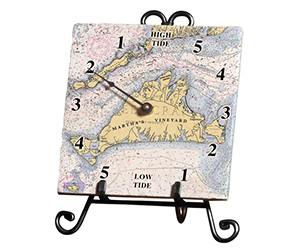Tide Clocks
How to set your tide clock
Properly set, our tide clocks are quite accurate almost anywhere in the world. However, the effects of the sun, as well as local weather conditions can cause the tides to vary, sometimes by as much as 1 1/2 hours during the course of the month. While there are always two high and two low tides per day, in some locations, such as the China Sea and parts of the Gulf of Mexico, the second high and low tides are so small that there appears to be only one high and low tide per day.
Starting Your Clock
Obtain a local tide table and a calendar that shows the days of the full moon, new moon, etc. Many newspapers publish this information, often near the weather report. On the day of a full moon, insert your battery precisely at the time of high tide according to your local tide tables. If your Tide Clock is set correctly on the day of the full moon, it will display the minimum error throughout the entire month. Usually the discrepancy will be less than 30 minutes and therefore unnoticeable. Typically, only four or five days each month will have a difference as great as an hour.
To make the best of your Massachusetts Bay Trading Company Tide Clock you should understand a little about what causes the high and low tides. The moon is the major cause of the tides. The lunar day, the time it takes for the moon to reappear at the same place in the sky, is 24 hours and 50 minutes. Most locations have two distinct high tides and two low tides each day. Therefore, the hand on our tide clocks rotates once every 12 hours and 25 minute, twice each lunar day. The Tide Clock will always stay in exact step with the moon. But there are many other factors that can make the day-to-day tides a little earlier or later than the Tide Clock shows. It is impossible for us to determine these conditions for your locality. The sun also affects the tides, but has less than half the influence of the moon. When the sun, moon and earth are lined up, as they are at time of the new moon and full moon, their influences combine and high tide is higher than normal and low tide is lower than normal. When the sun and the moon are at right angles, as they are at the first quarter and last quarter of the moon, the sun cancels some of the moon's effect and the range of tide is smaller than normal. At these times the sun will cause the tides to be somewhat earlier or later than average. This is why it is so important to first set your Tide Clock on the day of a full moon, as the moon has the dominating effect on the tides.
More information about tides
There are actually two tidal cycles: a twice-daily cycle and a once-daily cycle. On a tide when the two cycles help each other, high tides will be higher and low tides lower. On the next tide, when they conflict, the tidal range will be smaller. The relative strength of these two cycles varies from week to week, and also varies from one place to another. In the United Stares, along the Atlantic Coast the two daily tides have a similar range, but on the northern Pacific Coast there tends to be a large difference between the two daily tides. Farther south and in the Gulf of Mexico, the difference is so great there often appears to be just one high tide and one low tide per day. Abnormal atmospheric pressure can temporarily affect the time and height of tides. A difference of one inch in barometric pressure will cause about one foot difference in sea level. Strong on-shore winds will also cause a temporary increase in sea level. Both of these effects will change the times of low and high tides as well. Tides in the lower portions of rivers will be affected by the changing volume of the river flow.
During the 29 1/2 day synodic period (the time between new moons) the moon will have made exactly one less revolution around the earth. So that there will be exactly two less tides during that period of time. Therefore, the tidal period (time between high tides) will equal
29 1/2 days/(28 1/2 days x 2) tides = .5175 days = 12 hr. 25 1/4 minutes between tides.
Note: The crystal frequency in our tide clock is 31.658 kHz which makes one revolution of the lunar clock equal to a lunar day of 12 hours and 25.24 minutes or 1.03506 times longer than the solar day.
If the tide movement is set at a new or full moon high tide then the greatest error of up to 1 1/2 hours can occur about 3 to 4 days before or after neap (1/2 moon) or spring (full or new moon) tides, and the greatest accuracy is at new, 1/2, and full moons. The inaccuracies are not in the movement itself, but rather are due to the assumptions on which the tide movement is based. The assumption is that only the moon controls the tides. Although the moon has a dominating effect on the tides, the sun also has an effect (46% that of the moon) and the elliptical orbit of the moon around the earth can change the tides by +/- 20%. To a lesser extent, the elliptical orbit of the earth around the sun has a similar effect. All of these factors not only affect the magnitude of the tides, but they also affect the timing.


